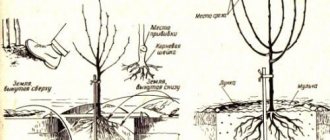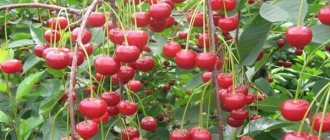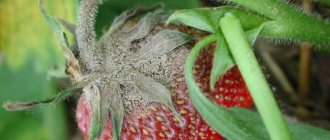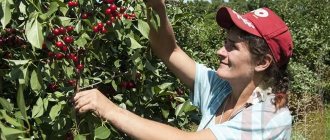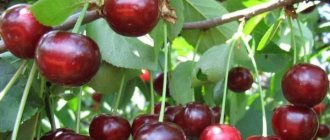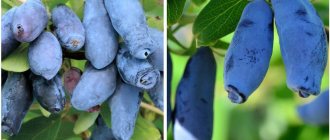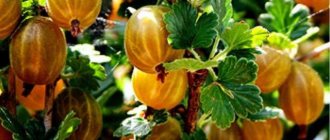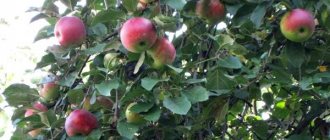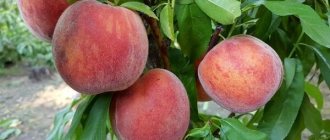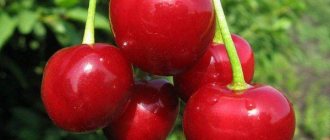Cherry Griot Moscow
Cherry Griot Mosskovsky. The variety was bred at the All-Russian Selection and Technological Institute of Horticulture and Nursery Kh.K.
Enikeev by selecting a clone of the Griot Ostgeimsky variety. Included in the State Register in 1959 for the Central Region. The tree is medium-sized - 2.5 m, the crown is wide-rounded. It bears fruit mainly on annual growth. The fruits are large 3.5-5 g, round, dark red in color. The berry taste is pleasant.
The variety is early-fruiting, the berries ripen on July 15-20, self-sterile, the best pollinators are Vladimirskaya, Pink Flask. Productivity is above average (8.6 kg per tree or 6-8 t/ha).
Winter hardiness of the tree and buds is above average, resistance to coccomycosis is average, resistance to moniliosis is below average. Advantages: mid-early productive, winter-hardy Moscow variety, with good quality fruits.
Stone fruits need to be planted in different areas in the spring.
In particular, it is important to note the lack of impact of the proximity of groundwater on the root system of the plant. This allows you to grow seedlings on soils with a variety of characteristics
Increased winter hardiness means there is no need to perform additional processes to insulate the plant. This variety is excellently grown in Russia in warm and northern regions.
It easily endures Russian winters without any difficulties.
Selection of soil and seedlings. Definitely, one way or another, you should choose the most favorable soil conditions for growing cherries. In particular, these are fresh soils rich in minerals and nutrients, which have high moisture and breathability.
When choosing a space for planting cherries, you should determine an area where the root system will not get wet during wet periods
It is important to pay attention to the wintering of young plants. It is recommended to cover their branches and lower parts for the winter so that the plants are not eaten by mice and hares
Zhukovskaya responds well to molding pruning and fertilization. Thus, during the rooting period of the plant, you can prune the branches at the top for further branching of the plant.
The variety is prone to high-quality lighting and for growing it is recommended to choose a space with plenty of light throughout the day. Since the variety has a round, spreading shape, you need to consider the location relative to other plants in your garden.
Over time, as the tree grows, it can block nearby plants. As a rule, the plant is supplied as annual grafted seedlings that have a developed root system. The upper part, to perform the correct shaping, is pre-cut to a size of about 50-70 cm.
For the root system, use packaging made of wet peat or moss, which is wrapped in a shipping wrapper. It is better to purchase seedlings that are grown in weather conditions similar to those of your suburban area. If you have such an opportunity, then choose seedlings with the largest number of roots.
In general, the variety belongs to the well-known popular varieties and is recommended for cultivation as a garden crop. The absence of additional wintering requirements is an important advantage.
During the formation process, attention should be paid to adjusting the height of the plant and pruning branches to spread the crown along, and not upward. Thus, the plant becomes stronger and more durable.
If shaping is not done, the cherry tree will grow tall, which can shade other plants in the garden and make it difficult to pick fruit from the highest branches.
Characteristics
- The early fruiting rate of cherries is not bad. The tree forms its first harvest 3–4 years after planting;
- flowering occurs in the second decade of May, so return frosts are not a big problem;
- In terms of ripening, the variety is mid-season. The berries ripen in mid-July;
- the variety is valued for its stable and annual ability to bear fruit;
- Griot Moscow does not shine with high productivity, but every year a small plant brings about 8.6 kg per tree, which is an indicator of average productivity. From one hectare it turns out 6.0 - 8.0 tons. In the most favorable years, the yield was 15.5 kg per tree;
- In terms of winter hardiness, the variety is much more hardy when compared with the parent Griot Ostheim. But in severe winters, this indicator is still insufficient, since freezing of not only fruit buds, but also vegetative parts is observed;
- immunity is not high enough. Our hero was given average resistance to coccomycosis from his parent; noticeable lesions can be observed in unfavorable years. Resistance to moniliosis is even lower;
- transportability and keeping quality are low. The cherries are very juicy, and besides, the cut is wet;
- The way to use the crop is universal. Berries in their natural form are good for health, although the taste is somewhat sour. Therefore, many classify the variety not as a table variety, but rather as a technical variety. Indeed, the crop is very suitable for processing.
Diseases and pests
The Moscow Griot cherry variety is resistant to diseases and pests. It even has immunity to fight scab, but is susceptible to coccomycosis and moniliosis.
Coccomycosis can be identified by brown spots on the foliage. Over time, they turn into large spots. A pale pink coating appears on the reverse side. Due to infection by this fungal disease, the foliage falls prematurely, which makes the cherry tree less resistant to winter.
To treat, you need to spray the tree three times. First in the spring, using a 3% solution of Bordeaux mixture. Then after flowering with a solution of copper oxychloride. The tree is sprayed a third time after harvesting with a 1% solution of Bordeaux mixture.
Moniliosis also refers to a number of fungal diseases. Affected leaves and branches appear scorched and eventually crack and die. An infected tree may develop a small gray growth on the bark that eventually begins to rot. In the fight against moniliosis, a 3% solution of Bordeaux mixture is also effective, which is used to treat the tree before buds open.
Diseases and pests, methods of control and prevention
| Disease/pest | Manifestation | Control method/Prevention |
| Coccomycosis | Affects leaves and fruits. Most often it appears in June in the form of small red spots and plaque. Affected areas of cherries fall off | Treatment with “Hom”, a solution of Bordeaux mixture. It is not recommended to leave fallen fruits and leaves under the tree. |
| Fruit mite | The insect attacks the foliage of the tree. It deteriorates and falls off. The variety stops blooming - due to the disease, the buds do not form | To combat the pest, spraying with insecticides is used. Cleaning the cherry trunk of old bark is considered a mandatory preventive measure. |
Protection from diseases and pests
As already mentioned, it has good resistance to fungal diseases such as scab. The same cannot be said about coccomycosis. This disease often affects plants, especially in rainy years. To prevent infection, trees are treated with special products in early spring before the buds swell and in late autumn, after the leaves fall.
In addition, an excellent means of preventing diseases and pests, including rodents, is bleaching the trunk and skeletal branches. The treatment is carried out with a lime solution with the addition of carbolic acid.
Cherry Griot Moscow description and characteristics
The main advantage of such a cherry can confidently be called a successful combination of high yield and good resistance to cold: the cherry variety was specially zoned for the capital and the Moscow region.
The main characteristics of this variety of cherry tree include the following:
- tree of medium height, rarely exceeding 3 m;
- the crown is dense, spherical;
- the average weight of each berry is about 3.5 g;
- The color of the fruits is very reminiscent of cherries - they are dark red, with one light side;
- the pulp has a high juice content, dark red, sweet and sour;
- the period of mass ripening occurs in the second half of July;
- When a berry is torn off from the stalk, a wet mark remains;
- each tree can produce up to 16 kg of fruit;
- The fruiting period begins in the 4th or 5th year of the tree’s life.
Features of growing the variety
Growing this variety is not much different from other varieties of garden cherries. For planting, it is better to choose a sunny, draft-free place where there is no danger of moisture stagnating in the soil.
Seedlings should be planted in the spring, after preliminary pruning of the branches, but without touching the roots. It is noteworthy that Griot Moscow, like most cherry varieties, is considered a self-sterile crop (in order for the fruits to appear, the plant needs pollen from other cherry varieties). But the concept of self-fertility is quite relative: for example, the Michurinskaya cherry, which is classified as self-fertile, still needs pollinators. Therefore, when planning to purchase a seedling, be sure to make sure that the young cherry is not alone in your garden.
When a calendar year has passed since you planted the tree and the cherry blossoms, be sure to pick off most of the flowers - this will help the plant take root better. A young cherry tree should be watered regularly - at least 4-5 times a month. For each tree you will need 1 bucket of water twice a day.
Griot Moscow cherry, as the description of the variety indicates, has a tendency to form numerous basal shoots. The latter should be regularly destroyed, since such shoots take away a lot of the tree’s vitality.
Despite the declared high winter hardiness, it is better to protect the crop from frost, especially during snowless winters: mulch the tree trunk with horse manure or any covering material to protect yourself from sudden “surprises”.
As they say, everything new is well forgotten old. Be sure to try growing cherries of the old, proven variety, and we assure you, you will be satisfied.
Video “Choosing the right cherry seedling”
From this video you will learn how to choose the right cherry seedling.
Appearance of Griot Moscow cherry
This cherry has the following structural features of the species:
Tree
Belongs to the category of medium-sized fruit crops. In adulthood, it grows to an average height of 2.5 - 3 m. Lyubskaya, Novella and Shalunya are also distinguished by their average height.
In this case, a fairly wide, densely leafy crown is formed, which, as a rule, has the appearance of a ball.
Escape. Quite thin. They have pronounced drooping. Leaves. They are characterized by medium size. They are distinguished by their ovoid shape. The edges are doubly serrated. Color – bright green, matte texture.
Fetus
Differs in average and larger than average sizes.
The average cherry of this variety weighs from 3 to 3.5 grams; in rare cases, the fruit can weigh 5 grams.
It has an almost regular round shape.
The color of the thin, delicate skin ranges from dark red to virtually black, with barely noticeable subcutaneous dots often appearing on it. Rossoshanskaya and Pamyati Vavilov have similar fruits.
Under the skin there is dark red pulp, abounding in juice. The medium-sized rounded bone is not very easily separated from the pulp.
Further in the article there are photos in which you will see what the Griot Moscow cherry variety looks like and a description of the characteristics.
Advantages and disadvantages
No variety of cherries can be called ideal, since all plants have their own advantages and disadvantages. The main advantages of Griot Moscow include:
- high level of productivity even when grown in not the most favorable climatic conditions;
- tolerance to temperature changes and night frosts;
- taste qualities of ripe cherries;
- rapid fruit ripening;
- resistance to most diseases.
The plant does not have many disadvantages, but they are still present.
The main disadvantages include the following:
- the harvested crop is poorly stored in winter and quickly deteriorates due to the excessive juiciness of ripened cherries;
- plants are often infected with coccomycosis, which can lead to the death of trees.
Features of the variety
The variety combines the qualities and benefits of cherries and sweet cherries, and was obtained from yellow cherry varieties using special processing. It has virtually no flaws.
Note! A variety of Michurinskaya cherry is Griot Michurinskiy cherry. .
Its berries are smaller (about 4-5 grams). But they are similar in composition: about 12% healthy sugars, 2% ascorbic acid and 33 mg of ascorbic acid per 100 grams of fruit. The berries of both varieties also contain fructose, glucose, vitamins A, B, C, a lot of iron, as well as amino acids.
This variety is used more for technical processing than for fresh consumption. This is due to the size of the fruit and its taste characteristics. But this variety is excellent for preparing and preparing various dishes.
Sunset
By the way, the Griot Michurinsky variety has other pollinators: Zhukovskaya, Molodezhnaya, Tamaris, Turgenevka. In addition, this variety is partially self-fertile. But you need to take into account that the yield will be low without pollinators. Griot's yield is slightly lower.
As you can see, the Michurinskaya and Griot Michurinsky cherry varieties are very similar, but there are differences between them.
Agricultural technology varieties
Landing
The location for the “Griot of Moscow” should be well lit by sunlight for most of the day. In the shade, the berries will be less sweet and the yield will be significantly lower.
Even with its frost resistance, cherry remains a heat-loving plant and it feels most comfortable in places hidden from strong winds. A cherry tree grows well on the south side of a house or a high fence.
Cherries grow poorly and ultimately die in areas prone to stagnant water and areas with high groundwater levels. The situation can be corrected by constructing a planting hill or organizing good drainage. In the case of high groundwater, when planting, a large sheet of iron is placed in the pit, which will prevent contact of the roots with underground water.
The ideal soil for stone fruits is well-fertilized light sandy and loamy soils. On heavy clay or dry and sandy soils, the root system will develop poorly, which will affect the general condition of the plant.
The planting pit is prepared in advance and filled with nutritious soil. Cherries are planted according to the same principle as all fruit trees. At the same time, we should not forget that the first stake to be installed in the planting hole is to which the seedling will be tied. If you miss this moment, it will be very difficult to install a support after planting the seedling without damaging the root system. Another important point when planting a cherry tree is the correct location of the root collar - after planting it should be located 3-4 cm above the soil surface.
Important! Cherry trees are very picky about neighbors in the area. Apple trees, pears and crops such as gooseberries and currants should not be planted next to them.
The best neighbors for cherries will be sweet cherries, cherry plums, elderberries and plums.
History of selection and region of breeding
In the 1950s, in the Soviet Union, which was forced to solve complex food problems of the post-war period, scientists were given the task of developing varieties of crops that would be able to produce good yields in difficult climate conditions.
One of the scientists who actively took up solving this problem was Doctor of Biological Sciences Khasan Enikeev (1910-1984).
A staunch follower and ardent propagandist of Michurin’s teachings, he found himself, as they say, in his element, since for several years before he had specialized in breeding winter-hardy varieties of plums and cherries.
The author of dozens of fruit species has always set his scientific goal to create crops whose fruits would have excellent taste.
In 1959, in Zagorye near Moscow, in the experimental vineyards of the All-Union Selection and Technological Institute of Horticulture and Nursery Growing, Professor Enikeev developed a new variety at that time - Griot Moskovsky.
Bush cherries with prospects for high yields were obtained as a result of cloning the Western European variety Griot Otsgeimsky.
According to its main parameters, the “Moscow branch” of the Griots was intended for zoning in the far-from-southern Moscow region.
But its cultivation quickly spread to the southern regions of the Russian Non-Black Earth Region and the Central Black Earth Region of the Russian Federation. Cherry varieties such as Vyanok, Shchedraya and Lebedyanskaya also grow well in these areas.
Also in 1959, Griot Moscow was included in the State Register. Since the mid-1960s, the variety was sent to state variety trials.
Appearance
Features of the variety created at the All-Russian Breeding and Technological Institute.
The Moscow Griot cherry tree is of medium size - about 2.5 meters. The greenery has a spreading, round shape.
The harvest is good and large - one cherry can weigh up to 5 grams. Externally, the berries are round, red and burgundy in color. They have a delicate taste.
Griot Moscow cherry is used in cooking, when creating drinks, and added to first courses
Characteristics of the tree and fruits
A medium-sized tree with brown bark grows quickly, its round-oval (or wide-pyramidal) crown is slightly raised, it is made up of thick, straight, hairless shoots with a small number of lenticels. The buds deviate greatly from the shoots. The smooth, dark green leaves have a narrow oval shape and jagged edges. The white, pink-shaped flowers are much larger than those of the cherry; one inflorescence contains 2–3 flowers. The fruits are formed on bouquet branches of different ages.
The fruiting dates indicated in the official description are valid for Michurinsk. They may vary slightly depending on the region, but they still arrive late (later even than such a well-known variety as Bryanochka). One mature tree produces up to 60 kg of berries. The berry is large, fleshy (average weight 5.5–6.5 g), has a beautiful dark red color of dense skin with a barely noticeable seam and a heart-shaped shape. The flesh is also red, juicy, the stone is smooth, oval-shaped, easily separated.
The taste is sweet with barely noticeable sourness. The berries are universally used; they are very good fresh, can be stored for several days and are easily transported. They are frozen and canned for the winter, and they are used to make delicious jam.
Caring for late cherries is somewhat different from caring for early varieties. This is explained by the fact that fruits take much longer to form, using much more resources.
Annual pruning is carried out in the spring. The first few years it is aimed at forming the crown in tiers - this makes it easier to care for the tree. Further pruning is of a sanitary nature. It is advisable to treat the places of all cuts and cuts with garden varnish.
Cherries love moisture. Michurinskaya late is watered once every month, but abundantly: a young tree needs 3-4 buckets of water, and a fruit-bearing tree needs a couple of buckets more. When the fruits have already grown and are actively turning red, it is better to postpone watering so that the berries do not crack.
Cherries are planted in a permanent place in the spring, and the pit is thoroughly filled with organic and mineral fertilizers in the fall. In the second year of growth, you can already apply fertilizing. They usually start with urea, which will need no more than 200 g per 1 square meter. m of tree trunk circle. In the third year, organic and mineral fertilizers are applied. Organic matter, as a rule, is applied every 2-3 years, but mineral fertilizers are added annually - urea in the fall, and superphosphates in the spring.
Review and brief description of popular cherry varieties for the Moscow region
Vladimirskaya . Tree from 2.5 m tall. The variety is medium-winter-hardy, has medium ripening periods. The fruits weigh from 2.5 to 3.4 g, dark red with gray dots. The taste is harmonious sweet and sour. Plants often begin to bear fruit after 2-3 years. The variety is self-sterile. Resistance to fungal diseases is average.
Lyubskaya . Winter-hardy, low-growing (up to 2.5 m) late-ripening variety. The fruits are heterogeneous in size, maximum weight 5 g. The taste of the berries is medium sweet with pronounced sourness, the fruits are more suitable for processing. The variety is early-bearing with a yield above average, conditionally self-fertile.
Turgenevka . Tall tree, from 3 m. The variety is partially self-fertile, with medium ripening periods. Frost resistance is high, does not freeze to - 35 degrees. Productivity is consistently high when placed with other pollinating varieties. The fruits are very large, 4-5 g, and have a pleasant taste.
Chocolate girl . A low tree with good winter hardiness, productivity and early fruiting. Fruit ripening period is July. The berries are quite large, 3.5 g, sweet. The variety is self-fertile. Sometimes it is affected by fungal diseases.
Youth . Productive, large-fruited variety with medium harvest time. Grows as a tree up to 3.5 m tall. It is winter-hardy, drought-resistant, and is affected by diseases only in rainy summers. The fruits, with an average weight of 4.5 g, have a good dessert taste. The variety is self-fertile.
Baby . Frost-resistant, early-ripening variety resistant to most diseases. Tree or bush up to 2.5 m tall, begins to bear fruit in the 4th year. The variety is high-yielding and large-fruited. Berries up to 6 g have an excellent sweet taste.
Novella . Tall, from 3 m, medium-ripening tree. The first harvest matures in 3-4 years. Winter hardiness is not high enough, but this variety is not susceptible to fungal diseases. The fruits are large, 4.5-5 g, the taste is sweet and sour.
Shubinka . An old variety of folk selection with late summer ripening. It is characterized by high winter hardiness and unpretentiousness, and rarely gets sick. Tree up to 4 m, begins to bear fruit in 5-6 years. Productivity is average. The fruits are small, 2.5-3 g, sweetish-sour taste, ideal for processing.
Miracle cherry . An early variety obtained by crossing sweet cherries and cherries. Self-sterile, pollinated only by cherries. Productivity is consistently high. Miracle cherry is one of the largest-fruited varieties: the weight of the berries reaches 10 g. The fruits are very sweet with a predominant cherry taste and aroma. Winter hardiness is average, the variety is not susceptible to fungal diseases.
Features of cultivation
In principle, the conditions for planting and care are no different from those for other varieties. Choose a place for cherries that is sunny and well protected from the wind. The preferred time for planting is early spring.
To do this, you need to dig a hole with a circumference of 60 cm and approximately the same depth, at the bottom of which fertilizer must be added. Add humus and potassium chloride to the dug soil and fill the roots, not forgetting to water the tree with settled water at room temperature.
Afterwards, the soil is mulched with sawdust and in the future it is necessary to regularly loosen it, water it, apply fertilizers, protect it from pests and diseases, and also trim it on time. Moreover, start forming the crown immediately after planting, removing a third of the length of the branches.
Remember that Grit Moskovsky is vulnerable to diseases such as coccomycosis and moniliosis. Share your tips and recommendations on the pages of my website, ask for help, and together we will harvest such a wonderful variety, which has been pleasing gardeners with tasty and healthy berries for more than half a century.
Description and characteristics
The description of the variety will help you study in more detail the main distinctive features of the plant and therefore it is better to familiarize yourself with it in advance. The history of the plant begins in the distant 50s of the last century, when biologist Khasan Enikeev decided to create a new cherry variety that would be resistant to temperature changes and high yield. The scientist managed to achieve his goals and create a new variety of bush cherry in 1959. At first, the plant was planted only in the Moscow region, since there are optimal climatic conditions for growing cherries. However, over time, trees began to be planted in other regions.
The Griot Moscow cherry variety is classified as a medium-sized plant, as mature trees grow up to three meters in height. During the growing process, a large crown appears on the plants, which looks like a ball.
The shoots of the plants are thin, with pronounced drooping. The leaves on the branches are distinguished by their oblong shape and smooth surface, painted green.
A distinctive feature of Griot Moscow is considered to be ripe cherries, the weight of which reaches 3-4 grams. When grown in a greenhouse, the weight of each ripe fruit can be more than 5 grams. All cherries have an almost perfect round shape. The skin of the fruit is dark red. Also on its surface you can see small subcutaneous dots, which are often found in the Memory of Babylon variety. Under the skin of the fruit there is a juicy and aromatic pulp, which makes the cherries very sweet and tasty.
Planted Griot of Moscow trees will grow for 15-20 years, after which they begin to fade. The first formation of fruits begins 5-6 years after planting the seedlings in the garden. If you grow cherries correctly, you can collect about 20 kg of fruit from one tree. However, achieving such a yield is quite difficult, and therefore most gardeners collect no more than 10 kg of fruit from a plant.
The variety was created for cultivation in regions with a temperate climate, and therefore experienced gardeners advise planting it only in central regions where there is no hot summer. Only under such conditions will it be possible to achieve maximum yield.
Characteristics of culture
Let's consider the main features of the variety, which is popular among gardeners.
Tree dimensions
Griot Moscow is a luxurious medium-sized tree that grows up to three meters in height. It has a spreading crown with densely spaced branches. The bright green leaves of medium size with a matte structure are endowed with an interesting ovoid shape. The maximum lifespan of a tree is 18 years.
Pollinator varieties and flowering
The Griot Moscow variety is self-sterile. Other pollinators are required for productive fruiting. Excellent fruiting is demonstrated when grown together with the following varieties:
- Shubinka;
- Vladimirskaya;
- Pink bottle.
Berry ripening time and tree yield
Cherries are early fruiting. The berries ripen evenly and are ready for consumption on July 15-20. The variety is very productive. With proper care and favorable ripening conditions, up to 17 kilograms of berries can be harvested from one mature cherry.
Application of fruits
Griot Moscow produces medium-sized, sour-sweet, juicy berries. The juiciness of the fruit requires careful handling. The berries are not suitable for transportation over long distances. They are consumed both fresh and processed. Cherries make very aromatic and pleasant-tasting jams, preserves and juices. Cherry liqueur and wine demonstrate excellent taste.
Immunity to diseases and insects
The variety is winter-hardy and resistant to a number of common diseases, such as coccomycosis and moniliosis.
Resistance to low temperatures and drought
The tree tolerates low temperatures and their sharp changes, characteristic of the Central region. During late spring frosts, blooming flowers also show resistance and rarely freeze.
See also
20 best varieties of cherries for the middle zone with descriptions and characteristics
Read
To maintain fruiting at a high level during periods of prolonged drought, Griot Moscow needs abundant watering. During the formation of ovaries and in preparation for wintering, watering is especially important.
Description and characteristics of the variety
Frost resistance
This cherry tolerates low temperatures well, it can be planted in the middle zone, but in Siberia and in the northern regions the trees will require insulation.
Productivity
The variety is very productive, you can get about 100-150 c/ha. From 1 tree you can get up to 65 kg of berries. The tree begins to bear fruit 5 years after planting. This cherry is a late ripening one. For example, in Michurinsk they begin to pick cherries from mid-late July.
Important! This cherry is self-sterile. This means that it will not produce a harvest on its own.
It is obligatory to plant such varieties of cherries as Pink Pearl and Michurinka nearby. These are pollinators.
Cherry Michurinskaya
Bloom
The flowers are white, slightly pinkish, large, and have a pleasant aroma. The inflorescence consists of 3 flowers. The plant looks very decorative during the flowering period. It blooms at the end of June.
Tree options
It is medium-sized, the crown is round-oval, the bark is brown, the shoots grow straight, the buds are oval. The leaves are bright, dark, green, smooth, oval-shaped, narrow, jagged.
Fetal parameters
The berries are heart-shaped, wide, dark red in color. The weight of 1 cherry is about 7 grams. They are juicy, sweet, with a slight sourness. The stone is easily separated from the fruit, smooth, round. The skin is dense. The stalk is thin, short and the fruits are easily removed from it.
On a note! The fruit contains almost 13% healthy sugars, almost 10 mg of ascorbic acid per 100 g of berries and 0.5 acids.
Characteristics of the variety
The described Griot Moscow cherry is a variety of universal practical use. Griot Moscow is equally well consumed both fresh and in the form of processed products (jams, preserves, etc.). Rovesnitsa, Volochaevka and Mayak are also distinguished by their universal application.
Its peculiarity is that it belongs to self-sterile varieties - the most numerous category of cherries. In other words, this variety is not capable of fertilization through self-pollination of its own flowers.
This means that for normal development and fruiting, trees of self-fertile species must be planted next to Griot Moscow. Rozovaya, Vladimirskaya, Shubinka, Shpanka Kurskaya, Orlovskaya Early and some other varieties are suitable for this.
Griot Moscow trees live on average 16-18 years. Productive fruiting begins 4 or 5 years after planting the seedling.
Subject to compliance with all strict agronomic requirements and proper care of this crop, it is capable of maximum productivity of 15-17 kg per tree.
But in practice, the usual average yield is lower, fluctuating between 8-9 kg per tree , which is approximately 6-8 tons of yield per hectare.
As noted above, this variety was developed for central Russia , which is characterized by a temperate climate , not very hot summers and frosty and very harsh winters with all the ensuing consequences for a heat-loving crop in principle.
As a result of targeted selection, Griot Moscow turned out to be much more winter-hardy compared to its original clone . According to observations, it usually tolerates Russian cold quite well.
The varieties Nadezhda, Tsarevna, and Pamyati Enikeeva also demonstrate high frost resistance.
However, if very severe frosts occur, this can cause the roots, branches and fruit buds to freeze. Therefore, a gardener growing this variety on his site should keep this feature in mind and take appropriate measures.
Griot Moscow cherry is a fast-growing variety. Its fruits, most often developing on the shoots of the first year of life, traditionally ripen between July 15 and July 20. The same sign is demonstrated by Ashinskaya Stepnaya and Lyubskaya.
The taste of the juicy ripe fruit is sweet, with a pleasant sourness. The fruits of this variety are mainly used for fresh table consumption. But often these cherries are also processed into juices and jam.
Due to its increased juiciness,
it is necessary to transport it, especially in large quantities, with great care.
As for the quantitative content of basic chemicals, the “portrait” of Griot of Moscow is as follows:
| Compound | Quantity |
| Sahara | 10,6% |
| Free acids | 1,5% |
| Solids | 13% |
Landing Features
For planting Moscow Cherry, as for other varieties, it is best to choose a well-lit place. Fruits in the shade will taste worse than others.
There should be no drafts and the groundwater distance should be at least 2.5 m. It is best to plant cherries on a small hill or mound.
Planting takes place in early spring. First you need to do a little pruning without disturbing the roots. The plant is self-sterile, so it needs an additional pollinator. A good harvest can be obtained if you plant the varieties Sklyanka Rozovaya, Shubinka, Orlovskaya rannyaya or Shpanka Kurskaya next to the Griot cherry.
The best soil to promote proper root development is sandy loam or loamy soil.
Landing rules:
- 2–3 weeks before planting it is necessary to prepare a hole with a diameter of 60x60 cm;
- add 20 g of superphosphate per 1 sq. m., potassium chloride 25 hectares per 1 sq. m.;
- drive a stake into the hole and tie a seedling to it;
- fill the hole with earth, compact it, the root collar should be 2–5 cm higher;
- after planting, make depressions and pour 20–30 liters of water into them;
- After watering, mulch with manure, compost or peat.
Care
Care begins with the right choice of seedling. Approximate parameters: height up to 1 m, age 1-2 years.
The root system can be either closed or open. Branching about 20 cm.
It is important to carefully examine the tree for diseases and damage.
Particular attention should be paid to examining the bark, because even small wounds can lead to serious illness.
It is better to purchase a seedling in spring or autumn.
Landing place
Cherries need to be planted in the spring. The late variety Michurinsky loves warmth and moisture, but does not tolerate wind. You need to choose a site closer to the south.
You need to plant before the buds open. An important point - you cannot plant a seedling in the place of old cherries.
Landing
The hole should have a depth of 60-70 cm, a width of 80 cm. In the middle you need to fill:
- organic fertilizers (manure, chicken droppings, wood ash, etc.);
- superphosphate;
- potassium chloride.
Drive a peg into the center for support. The distance between seedlings is 3 m.
Before planting, the roots can be soaked in water. Before placing it in the hole, the root system must be straightened. Then fill it with soil, lightly compact it and water immediately, but not near the trunk. You should dig a small trench and pour the required amount of water (3-4 liters) into it.
Top dressing
It is important to fertilize not only at planting, but also after several years of growth.
In the spring, before the buds open, double superphosphate, potassium salt and ammonium nitrate should be added to the soil. After the cherry tree has bloomed, you can feed it with wood ash.
Description of mineral fertilizers:
- Superphosphate is a phosphate fertilizer. Helps improve metabolism, increases productivity. It must be added during autumn digging.
- Potassium salt is used to improve soil quality. Helps stimulate growth. It is better to fertilize with potassium salt in autumn or early spring. For the late variety of Michurinskaya cherries you will need 5 g.
- Ammonium nitrate is fed in the spring. It is needed to saturate the plant with nitrogen. Complex fertilizers provide excellent results. An effective solution consists of 10 g of urea, 10 liters of water, 25 g of superphosphate, 15 g of sodium chloride. It should be applied during flowering. This is enough to feed 5-6 trees.
Trimming
It is worth starting pruning immediately after planting. In subsequent years, you can only form the crown.
The best shape for a fruit tree is a main trunk and tiers with 6 branches.
Be sure to trim branches that grow inward. They create thickening, and this reduces yield.
Wintering
One of the problems is freezing. Fed and healthy trees suffer much less.
The seedlings will not freeze too much if their trunks are whitened in advance. This needs to be done in October. Another way to protect a tree from freezing is to feed it with wood ash in the fall.
Watering
Michurina cherry can go for a long time without watering. The tree is watered 3-4 times a year. This is approximately 5-7 buckets.
The first watering should be done after flowering, the second occurs during the formation of fruits, the third after harvesting, and the last at the end of autumn.
Mulching
Mulching is very important for cherries. The mulch layer should be at least 5 cm. It is important to ensure that sawdust and straw do not come into contact with the trunk. You can mulch with compost.
This helps improve tree growth and keeps the cherries from freezing in the winter.
Features of growing Vyanok cherries
When cultivated, the variety will not cause much trouble for the gardener; growing it is no more difficult than any other cherry.
Landing
Spring is the best time to plant cherries, but it is better to stock up on seedlings in the fall, when nurseries have a larger selection of high-quality planting material. You also need to take into account the early awakening of the crop: in the spring there is a risk of buying a plant that has come out of dormancy, which is extremely undesirable. The purchased seedling must be preserved during the winter, and in the spring, choose the time for planting before the sap begins to flow.
The growing conditions of the variety are standard for the crop:
- a well-lit slope of southern or western exposure with air and soil drainage;
- light and medium loams with a reaction close to neutral;
- The occurrence of groundwater is not higher than two meters.
The scheme for planting tall trees in an amateur garden is 3x4 m. Seedlings are planted, adhering to the usual requirements for planting cherries.
The crown of a tall tree can be formed in a sparse-tiered form, well known to gardeners, but for cherries the best formation is considered to be without tiers. In this case, a low trunk is left (30–40 cm) and over the course of 3–4 years, 8–12 skeletal branches are formed, directed in different directions, keeping a distance of 10–15 cm between them. Then the central conductor is cut out to limit the growth of the tree. WITH
Anitarian and regulating (thinning) pruning is carried out regularly. You should not allow the crown to thicken, so as not to provoke the appearance of fungal diseases. To stimulate fruiting, shoots are shortened to a side branch.
The most suitable formation for tall cherries will be tieless
The variety is drought tolerant, so it needs additional watering only in case of insufficient moisture . During the dry season, plants are watered during periods of most active growth:
- after the formation of the ovary;
- during the filling of fruits and the laying of generative buds.
When watering cherries, you should not allow water to stagnate; it will cause more harm than lack of moisture. The soil should be moist and loose.
The fertilizing schedule is standard for the crop: in the spring the plants need nitrogen, in the summer - potassium, in the fall phosphate fertilizers are applied before digging. Plants respond well to summer feeding with liquid organic substances in the form of solutions of fermented cow manure or chicken droppings. Once every three years, dry organic matter (humus or compost) is added during autumn or spring digging: on depleted soils in the amount of 8–10 kg/m2, on soils with an average level of fertility 4–6 kg/m2 will be sufficient.
How plants can be affected
Considering the average immunity of the variety to coccomycosis, as well as the ambiguous assessment of resistance to moniliosis, special attention must be paid to disease prevention, otherwise it will be possible to miss not only the harvest, but also the tree itself . Standard sanitation work should be carried out regularly, which will also be effective against possible pest damage. In autumn and early spring, plants should be treated against fungal diseases with Bordeaux mixture or other copper-containing preparations, to which insecticides should be added to protect against harmful insects.
The most likely diseases have the following symptoms:
- With coccomycosis, brownish-brown spots appear on the upper side of the leaves, and white or pinkish sporulation pads of the pathogen appear on the lower side.
With coccomycosis, brownish-brown spots appear on cherry leaves and premature leaf fall occurs.
With moniliosis, the leaves and young shoots of cherries look burnt
Fruits affected by moniliosis become covered with dirty brown growths and rot.
When signs of disease appear, trees are sprayed with fungicides after flowering and twice more with a break of 10–12 days (Horus, Skor, Abiga-Pik and others).
Video: cherry disease coccomycosis
Varietal features
The name of the cherry clearly indicates for which region the variety was bred. The breeders had a clear task, as a result of their work, to obtain cherries that were resistant to the low winter temperatures of the Central region of Russia. They successfully managed to do this. In addition to excellent frost resistance, the variety was distinguished by strong immunity to such a terrible and widespread disease as scab, as well as high yield rates. The combination of these qualities in the difficult post-war years contributed to the rapid spread of the “Griot of Moscow” beyond the Central region. To this day, it is successfully grown throughout almost the entire country.
The ripening time of cherries of this variety is described by the originator as mid-early. In the Moscow region, the harvest time falls in the middle of the summer season - July 15-20. In the south of Russia, where “Moscow Griot” is very common, the berries ripen in late June and early July. In regions with late and cool spring, these dates shift closer to August.
Biological description of the tree
The plants of this variety are characterized by the following features:
If you have papillomas, read - before they are removed! This gets rid of parasites in 2 days and forever... Read more...
- a bush-type tree has an average height of 2.5 meters;
- the crown of mature trees is dense and spherical;
- foliage is strong;
- medium-sized shoots are directed towards the ground;
- the leaf blades are small, have the shape of an elongated oval and are green in color;
- cherry blossoms with white flowers collected in umbrella-shaped inflorescences;
- Trees begin to bear fruit after 4-5 years of planting.
Characteristics of berries and their use
Griot Moskovskiy berries have an average weight of about 3.5 grams. If there is a lack of moisture, they are crushed to 2.8-3.0 grams. The color of the skin is almost black, with a burgundy tint. The pulp is medium dense and contains a large amount of juice. When torn from the stalk, the skin is often damaged. The stone is small and difficult to separate from the pulp. The taste is good. The taste of the berries is classic cherry, sweet and sour with a bright aroma.
The variety has a universal purpose. The berries are good both fresh and in various processings. But the fruits of the “Moscow Griot” are not suitable for sale and transportation over long distances due to the raw tear and too juicy pulp.
Interesting! Fresh cherry juice is an excellent remedy for cough. Freshly squeezed juice with the addition of honey is good for treating bronchitis.
Features of pollination
Almost all stone fruit trees and shrubs are self-sterile. Griot Moscow cherries are no exception. Therefore, high-quality pollination of the cherry tree is a guarantee of rich fruiting. This requires cherries, the flowers of which bloom at about the same time. However, not all varieties that bloom at the same time are able to cross-pollinate each other. The following cherries are suitable for successful cross-pollination of the “Moscow Griot”:
- Vladimirskaya;
- Pink bottle;
- Orlovskaya Early.
Productivity
Yield indicators vary greatly depending on the area and growing conditions. The maximum recorded yield from one tree is 15-17 kilograms. With minimal care and even in unfavorable conditions, the yield remains at the level of 8-9 kilograms.
Variety varieties
The main subspecies of the Griot cherry are presented below.
Belorussian
Belarusian Griot is a tall cherry tree with a pyramidal crown. The species appeared due to the combination of Ostheim and Novodvorskaya cherries.
Specifics:
- Fruits weigh 5-7 g.
- Medium ripening of the variety.
- The taste is sweet and sour.
- This cherry is not afraid of a number of diseases.
- The tree needs an external pollinator.
Melitopol
The next variety is Melitopol cherry, created by Ukrainian breeders. In addition to the strong tall trunk and white flowers, what else is notable about it:
- Early ripening of the crop. The first cherries are harvested in the 4th season after planting.
- The large fruits are red and have a shine.
- Taste quality is rated 4.7 points out of 5.
- Easy to care for: this cherry is not susceptible to cold and drought, as well as a number of typical diseases.
- Pollination is necessary.
Moscow
The Griot Moscow cherry was bred at the Institute of Horticulture using the selection of Griot Ostheimsky. Advantages:
- Large berries, rich harvest.
- Delicate taste.
- Frost resistance.
- High resistance to coccomycosis.
Ostheimsky
The description of the subspecies notes that:
- The harvest is ripening quickly.
- The fruits can be used fresh or processed.
- Dense crown of round shape.
- Average height of a cherry plant.
- Cold resistance is average.
- There is susceptibility to disease.
The variety of cherry determines its appearance and taste.
Rossoshansky
Individual characteristics of the Rossoshansky Griot:
- 5-6 meter tree with abundant greenery. The bark is gray in color.
- The berries are medium in size, slightly flattened.
- Tender pulp of cherries, bright red juice.
- The taste of the fruit is cherry with sourness.
- The stalk is easily separated.
- Self-fertile variety.
- Feels good even in winter. Immunity to moniliosis is high, and immunity to coccomycosis is very low.
Basic rules of care
The health of the cherry and the result of cultivation depend on the provision of an appropriate microclimate. To do this, you need to follow some rules.
Landing place
The place for the plant should be well lit and protected from the winds. The southern part of the garden meets these requirements. The distance between trees must be maintained according to the scheme 2 * 2 or 2 * 2.5.
Watering
The first moistening is done during planting (2-3 buckets of water). The water should be warm and settled. After this, the soil is mulched with sawdust in a layer of 2-3 cm. The procedure helps retain moisture in the soil and prevents its cracking. The following waterings are carried out regularly - 4-5 times throughout the month. During the day, the soil is moistened 2 times, adding 1 bucket of liquid. Each watering is combined with weeding the soil around the trunk.
At the end of September, the tree is prepared for the winter period by watering it abundantly. 5-10 buckets of water are poured under one tree.
Top dressing
Nutrients will help increase productivity. To do this, fertilizers are applied in spring, summer and autumn. In spring, the procedure is performed in 3 stages:
- Before flowering, use a solution: 10 liters of water, 10 g of urea, 25 g of superphosphate, 15 g of potassium chloride.
- During flowering, the same remedy is used.
- 2 weeks after the previous one, an infusion is prepared: 10 liters of mullein, 50 liters of water, 1 kg of wood ash. Insist for 5 days. Half of the prepared infusion is added under one tree.
After fertilizing, it is worth watering the plant with 2 buckets of water. In summer, you can fertilize cherries using a solution of a complex mineral product. Foliar feeding is also used. Treat the wood with succinic acid or sodium humate.
Autumn fertilizers help increase winter hardiness and next year's harvest. During this period, cherries are provided with potassium and phosphorus. At the same time, organic matter is added.
Trimming
The correct procedure helps to increase productivity, resistance to diseases, and also corrects the sugar content of berries. They begin to form the crown immediately after planting. To do this, all branches of the seedling are cut by 1/3.
Regular pruning is done in early spring, 18-20 days before the buds swell. It is recommended to do it according to the following rules:
- remove dry and damaged branches - this will help thin out the crown and prevent the proliferation of pathogens;
- do not spare fruit-bearing branches that come into contact with the ground;
- When fully pruning, the branch must be cut off near the base, without leaving stumps.
General rules for planting and caring for cherry seedlings
It is best to plant cherries in the spring before the leaves bloom. Planting holes and soil mixture are prepared in the fall, placing them in well-lit and protected from the wind places with deep groundwater. The distance between planting holes is about 3 meters.
After planting, the seedlings are watered and the soil is mulched. Fertilizers begin to be applied at the beginning of fruiting. It is enough to feed the trees in the spring, after flowering, twice with an interval of 2 weeks.
The crown must be trimmed regularly, shortening the shoots to 50 cm and completely removing branches growing inside the crown. It is better to do this in early spring. The root shoots are also cut off.
Planting seedlings
Separate holes are prepared for each individual seedling of late Michurinskaya cherry. The diameter of each must be at least 60 cm. The depth of the planting hole must be at least ½ meter.
A mixture is poured into the bottom of the pit, which consists of:
- humus;
- turf;
- sand.
All components are taken in equal parts. Superphosphate and potassium chloride are also added.
The hole should be 2/3 full. Be sure to water the soil abundantly. A peg is driven into the center for support.
The seedling is placed in the prepared hole. The roots are straightened out as much as possible. Next, sprinkle with earth without burying the tree.
A depression is made around the Michurinskaya trunk and at least ten liters of water are poured into it. It is better to use settled and warm water.
Afterwards the young tree is pruned. The shoot should be no more than 60 cm in height.
Planting scheme
When planting Michurinskaya cherries, the holes for seedlings are placed at a distance of at least five meters from each other. This is done so that mature trees do not interfere with or shade each other.
Disembarkation period
It is recommended to plant cherry seedlings in the spring, when the soil is sufficiently warm.
If you plant a tree in the fall, it will not have time to get stronger before the onset of cold weather and frosts. The seedling will die.
Rules for planting and care
It is recommended to familiarize yourself in advance with the rules for planting and caring for planted trees.
Planting
Planting most seedlings begins with choosing the most suitable place in the garden. Experienced gardeners recommend planting cherries in an area that is illuminated by the sun throughout the day. Trees cannot be grown in shaded areas, as this negatively affects the yield. Also, you should not plant cherries in gardens with high groundwater levels. Due to increased soil moisture, planted trees may die.
Having chosen a suitable place, they begin planting seedlings. First, a planting hole is made in which the cherry will be planted. To do this, a pit about 40-50 cm deep is dug in the ground, into which organic fertilizers are added.
Then the seedling is carefully placed in it, covered with soil and watered.
Care
To increase productivity, you need to constantly care for the planted cherries. During care, you will have to periodically water the trees so that they have enough moisture. It is enough to moisten the soil 1-2 times a month.
You should not water the plant more often, as high soil moisture may cause the root system to rot.
In addition to watering, they fertilize to saturate the soil with nutrients. For the first time, fertilizers are added to the soil 2-3 years after planting cherries. Nitrogen is added to the soil in the spring, organic matter is added in the summer, and phosphorus and potassium fertilizers are added in the fall.
Protection from diseases and pests
Griot Moscow almost never gets infected with scab, but other diseases can harm the plant. Cherries are often infected with moniliosis and coccomycosis. Due to these fungal pathologies, large brown spots form on the surface of the leaves, and a pink coating appears on the inside. If you do not treat the cherry tree, the leaves will gradually begin to fall off, which will lead to the death of the tree.
To treat plants, you should use a solution of copper sulfate. Also, in the fight against fungal diseases, Bordeaux mixture is used, with the help of which pathogens of pathologies are eliminated. To protect trees from diseases and pests, they should be treated with fungicides in the summer. It is enough to spray the plants twice a season.
Preparing for winter
Some gardeners are sure that frost-resistant varieties of cherries do not need preliminary preparation for winter, but this is not so.
In the second half of autumn, the following preparatory work must be carried out:
- tree trunks are treated with lime liquid;
- at the end of November, all cherries are watered abundantly to saturate the soil with moisture;
- All dry fruits and leaves are removed from the trees;
- the soil around the plants is cleared of fallen leaves;
- the area is dug up and fed with mineral and organic fertilizers.
If you do not prepare trees for winter in advance, the yield can deteriorate significantly.
Advantages and disadvantages of Griot of Moscow
The hybrid variety belongs to the collection of old Soviet selection and cannot be called ideal. In addition to a number of advantages, it also has some disadvantages. Let's list the main pros and cons of cherries.
pros
- abundant and annual fruiting even under unfavorable conditions;
- trees tolerate low winter temperatures in the Central region;
- Scab resistance is above average;
- early fruiting (first harvest in the 4-5th year of planting);
- good taste of fruits;
- universal for purpose.
